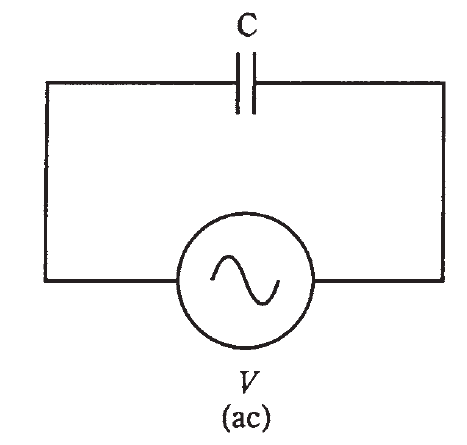


 الفيزياء الكلاسيكية
الفيزياء الكلاسيكية
 الكهربائية والمغناطيسية
الكهربائية والمغناطيسية
 علم البصريات
علم البصريات
 الفيزياء الحديثة
الفيزياء الحديثة
 النظرية النسبية
النظرية النسبية
 الفيزياء النووية
الفيزياء النووية
 فيزياء الحالة الصلبة
فيزياء الحالة الصلبة
 الليزر
الليزر
 علم الفلك
علم الفلك
 المجموعة الشمسية
المجموعة الشمسية
 الطاقة البديلة
الطاقة البديلة
 الفيزياء والعلوم الأخرى
الفيزياء والعلوم الأخرى
 مواضيع عامة في الفيزياء
مواضيع عامة في الفيزياء|
Read More
Date: 2-4-2021
Date: 25-4-2021
Date: 13-4-2021
|
Capacitors and alternating current
Suppose that the source is changed from direct to alternating current (Fig. 1). Imagine that you can adjust the frequency of this ac from a low value of a few hertz, to hundreds of hertz, to many kilohertz, megahertz, and gigahertz.

Fig. 1: A capacitor across a source of ac.
At first, the voltage between the plates will follow just about exactly along as the ac source polarity reverses over and over. But the set of plates has a certain amount of capacitance, as you have learned. Perhaps they can charge up fast, if they are small and if the space between them is large, but they can’t charge instantaneously.
As you increase the frequency of the ac voltage source, there will come a point at which the plates do not get charged up very much before the source polarity reverses. The set of plates will be “sluggish.” The charge won’t have time to get established with each ac cycle.
At high ac frequencies, the voltage between the plates will have trouble following the current that is charging and discharging them. Just as the plates begin to get a good charge, the ac current will pass its peak and start to discharge them, pulling electrons out of the negative plate and pumping electrons into the positive plate.
As the frequency is raised, the set of plates starts to act more and more like a short circuit. When the frequency is low, there is a small charging current, but this quickly tails off and drops to zero as the plates become fully charged. As the frequency becomes high, the current flows for more and more of every cycle before dropping off; the charging time remains constant while the period of the charging/discharging wave is getting shorter. Eventually, if you keep on increasing the frequency, the period of the wave will be much shorter than the charging/discharging time, and current will flow in and out of the plates in just about the same way as it would flow if the plates were shorted out.
The opposition that the set of plates offers to ac is the capacitive reactance. It is measured in ohms, just like inductive reactance, and just like resistance. But it is, by convention, assigned negative values rather than positive ones. Capacitive reactance, denoted XC, can vary, just as resistance and inductive reactance do, from near zero (when the plates are huge and close together, and/or the frequency is very high) to a few negative ohms, to many negative kilohms or megohms.
Capacitive reactance varies with frequency. But XC gets larger (negatively) as the frequency goes down. This is the opposite of what happens with inductive reactance, which gets larger (positively) as the frequency goes up.
Sometimes, capacitive reactance is talked about in terms of its absolute value, with the minus sign removed. Then you might say that XC is increasing as the frequency decreases, or that XC is decreasing as the frequency is raised. It’s best, however, if you learn to work with negative XC values right from the start. This will be important later, when you need to work with inductive and capacitive reactances together in the same circuits.



|
|
|
|
4 أسباب تجعلك تضيف الزنجبيل إلى طعامك.. تعرف عليها
|
|
|
|
|
|
|
أكبر محطة للطاقة الكهرومائية في بريطانيا تستعد للانطلاق
|
|
|
|
|
|
|
العتبة العباسية المقدسة تبحث مع العتبة الحسينية المقدسة التنسيق المشترك لإقامة حفل تخرج طلبة الجامعات
|
|
|